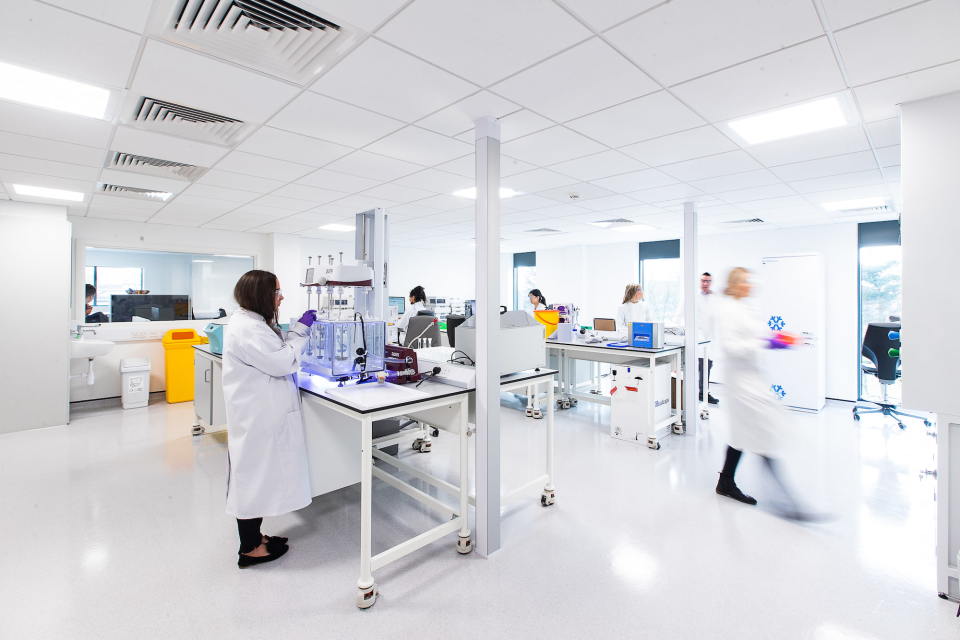The Future of Lab Design
By Bruntwood SciTech

Never has the UK life sciences sector been more in the spotlight than in this past year, from testing and drug discovery to the roll out of the vaccine, collaboration and open innovation have been vital in accelerating scientific progress and will be central to the future of the laboratory. So how is the design of the lab evolving alongside the UK’s thriving life science sector?
Our property director, Pete Crowther explored the topic in a recent webinar with Bidwells focussed on ‘Lab design for the future’...
“In such a globally competitive market, the design and function of lab space is essential for the growth and success of life science businesses and the UK life science sector as a whole.
It's less about the lab as a silo and more about the need for physical collaboration, breakout spaces and wellbeing. Quick access to talent and expertise is essential for growing businesses, meaning that lab space in itself needs to be in the right place with access to the right scientific networks.
If you cluster life sciences and tech businesses together in the right way it will create faster routes to market and product delivery as they start working together and collaborating. And it’s not just about understanding the landscape.
There is an imperative need to understand the end user. We know that larger companies want to be in the mix of new research from start-ups, while SMEs desire access to partners, potential customers and co-innovators so it’s about getting the right businesses into the right spaces and ensuring that we support them in providing the planning and design capability.
It’s important that we become an extension of a company’s team, identifying the right plant space and service space for the company, and making sure we truly understand their needs. This is a huge step change from the days of big pharma. The ingredients for success from startups and scaleups through to global companies will inevitably be different, but opportunities for this type of knowledge exchange and partnerships is always beneficial for business. Flexibility in lab space is key.
Companies are moving faster than ever through their scientific lifecycles and often struggle to find lab space at scale at the speed they need it. Labs are also always evolving with new technology, which is why custom built labs are essential for life sciences businesses who know exactly what they need and where. We need to be creating flexible space that is able to grow with the company as they evolve and be adaptable to future technologies.
Evolving technology such as smaller and smarter lab equipment that releases a lot of heat must also be considered in lab design. The increase in robotics and automation might mean an increased emphasis on the importance of space planning, whilst other technology might determine how air is recirculated, cooled and conditions monitored. Designing and fitting out labs, and keeping them up-to-date is an expensive capital cost.
The equipment and technology within the lab is continuously getting smarter, smaller, and often comes with a large price tag. For smaller businesses, it’s really important that we support them by providing them with access to shared state-of-the-art equipment and lab services such as coworking and open access labs, invivo research facilities and NMR equipment, which will help give them the kick start they need without the upfront capital investment and cost risk.
By providing such facilities and infrastructure, it enables life science businesses to focus on the science and on scaling and growing. The development of the Lighthouse Lab national Covid-19 testing facility at Alderley Park is a great example of how when it all comes together, it really works.
We led a multi-disciplinary team with expertise in lab design, facilities management, operations, people, logistics and waste to create an operational laboratory for the Medicines Discovery Catapult in just 3 weeks. And let’s not underestimate how Covid-19 has changed the format of the lab too.
Throughout the pandemic, stringent levels of cleanliness; the introduction of thermal cameras, socially distanced spaces and remote, touch free access controls have all become the norm in lab design. During the pandemic, what we have seen is a real variation in terms of people's attitudes to the workplace. Occupancy levels for lab space have been in excess of 70% over the past year, however life science companies are still increasingly looking to smart technologies to support them in creating safer workplaces.
Health and wellbeing are absolutely key and this is a trend that we’re seeing accelerating. It isn’t just the physical environment people find themselves in, but looking within the lab and within the building. The better the environment, the better people tend to perform.
Our expectation is that the future of the lab is more about the cluster than an individual asset. And that’s the key thing we try to focus on. None of the above, however, can be taken individually as an ingredient for success when it comes to lab design and growing a life sciences business.
It is all of these together, from physical design and lab flexibility, to evolving alongside new technologies and facilitating knowledge exchange and partnerships between businesses, that play a part in forward-thinking lab design and business success.’’
Stay Connected!
Sign up to our newsletter for the latest news, updates and offers.